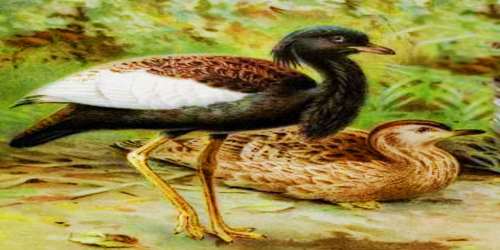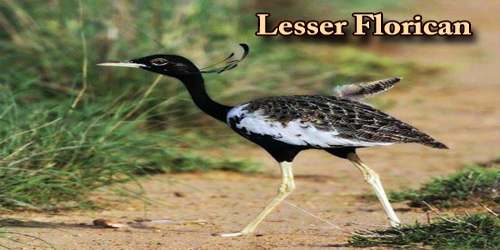The lesser florican (Sypheotides indicus), also known as the likh or kharmore, is known for its spectacular aerial courtship displays in which the male springs upright in the air in a flurry of wings and legs, doing so as many as 500 times a day. It is the smallest in the family of bustards and the only member of the Sypheotides genus. It is native to the Indian Subcontinent where it is found in tall grasslands and is best known for the male monsoon season’s leaping breeding displays. Unfortunately, this eye-catching display left males very vulnerable to both food and sport hunting. The shooting started in earnest in the 1870s, continuing for decades, and was responsible for the drastic decline in numbers over this time, aggravated by the open grassland being their preferred habitat. The species is highly endangered and some parts of its range, such as Pakistan, have been extirpated. It is endangered by both hunting and the destruction of habitats. The only related species is the larger Bengal florican (Houbarobsis bengalensis) that lacks the white throat, collar, and elongated feathers. The Lesser Floricans are mostly endemic to India, but some occur sporadically in tiny numbers in Pakistan, with four reports from Nepal from non-breeding individuals. The concentration of the population is in northwestern India.

Lesser Florican Pair (Male & Female)
This species inhabits grasslands and open fields, particularly ungrazed areas with grass ~1 meter high but also tolerates variations in shrub density, from more open vegetation to dense forests. A male in plumage breeding has a blackhead, a neck, and lower parts. Its throat, however, is white. Around three 4 inches long, ribbon-like feathers arise from behind the ear-coverts on both sides of the top and extend backward, curving up and ending in a spatulate tip. the rear and scapulars are mottled in white with V-shaped marks. The wing coverts are white. After the breedings season, the male tends to own some white within the wing. The female is just a little bigger than the male. In non-breeding plumage, the females and males are white with black stripes on the head and neck with darker markings. The rear is mottled and black-barred. The neck and upper breast are buffs with the stripes falling towards the chest. The outer primaries of the males are thin and notched on the inner-web. Pale yellow wings, and yellow iris. Young birds have a distinct U-shaped mark on their necks near their throats. Movements are not well known outside of breeding season. These are omnivores, which feed on insects, frogs, small lizards, leaves, crop shoots, herbs, and berries. They are also known to feed on seeds, leaves, herbs, and berries. They have a lekking mating system where special aerial displays are performed by males. Females have a nest protective display involving spreading the feathers of their wings, tail, and neck. It’s said the females produce a whistling call that attracts males. Males are aggressive towards other males in the neighborhood. The nest is a shallow scrape on the ground and 3-4 (1.88 x 1.6 inches) eggs are laid. Normally the nest site is in thick grass. Females play a primary role in incubation and chick-rearing. The incubation time is about 21 days.
















